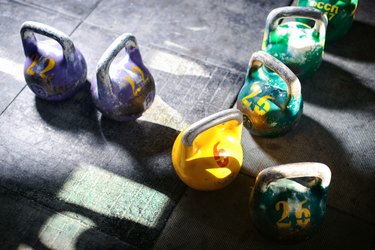
Whether you have a special event coming up or you're just tired of not being able to fit into your favorite pair of skinny jeans, reducing your body fat can seem like a dire emergency. The good news is, there are ways to tweak your diet and exercise program to accelerate fat loss. The bad news is, it's not going to happen overnight.
Tip
The fastest way to reduce your body fat percentage is to lower your calorie intake and increase your activity level.
Video of the Day
How to Accelerate Fat Loss
Fat loss depends on myriad factors, many of them out of your control. For example, your genetics play a role in how easy it is for you to lose fat, according to the National Institute of Diabetes and Digestive and Kidney Diseases, as do any health conditions you might have or medications you may be taking. However, your calorie intake and expenditure is one area you can control.
Video of the Day
By reducing your calorie intake and increasing your physical activity level, you can create a calorie deficit so that the calories you consume each day are lower than the calories you expend. This causes your body to cease storing fat and start burning it.
Maybe you're already doing the calorie deficit thing, but you're not seeing results as fast as you'd like. In that case, you may need to further reduce your calorie intake and up the ante on your exercise program. These two modifications will help you create a deeper calorie deficit and speed up the drop in your body fat percentage.
Stick to a Safe Rate of Weight Loss
The deeper your calorie deficit, the more weight you'll lose in a shorter period of time. How much? Well, one widely accepted theory is that 1 pound contains about 3,500 calories, and for every 3,500-calorie deficit you create, you'll lose 1 pound.
That theory's got its flaws because fat loss doesn't fit into a nice, neat little equation. It's affected by many different things and moves at different speeds for different people.
But you can use that concept to understand a calorie deficit, and then set your goals accordingly. According to the Mayo Clinic, if you create a daily calorie deficit of 500 to 1,000, you can lose approximately 1 to 2 pounds of fat per week, 4 to 8 pounds per month and so on. Perhaps you're already working with a 500-calorie deficit — to speed things up, it will pay to strive for that 1,000-calorie deficit.
Now you might be thinking, "I could create a 2,000-calorie deficit and lose double the fat in the same amount of time!" Don't go there. Losing weight very quickly isn't healthy, and it won't result in lasting fat loss.
Rapid weight loss often requires a very low-calorie diet and changes in exercise that are unsustainable over the long term. Additionally, losing weight quickly doesn't necessarily mean you're losing fat. The Mayo Clinic suggests that it's difficult to burn that many fat calories in such a short time, and you might be losing water weight and muscle mass instead.
How Long Does It Take to Lose 1 Percent Body Fat?
There are no official guidelines on what rate is healthy when it comes to dropping body fat percentage, but according to the American Council on Exercise, it's generally safe and doable to lose 1 percent body fat in about a month.
Balance Your Diet
Depending on how many calories you currently eat, you can make some headway with your diet. Theoretically, you could karate chop 1,000 calories from your diet and you wouldn't even have to exercise. But that is likely to be very challenging. Plus, exercise is good for you.
Instead, aim for a more realistic 500-calorie deficit. This doesn't take too much calorie counting or deprivation; often it just means making a few small changes to reduce your intake of less-healthy foods and increase your intake of more nutritious foods.
Foods to Avoid
The first thing to stop is sugar. You can't consume a lot of sugary foods and beverages and get lean. Not only is sugar bad for your health, non-nutritive and not filling, but it also has effects on appetite and satiety that can cause you to overeat, according to Harvard Health Publishing. Some foods are obvious sources of sugar:
- Candy
- Cookies, cakes and pastries
- Ice cream
- Soda and sweet tea
But there is added sugar lurking in places you might not expect it, like:
- Cereals
- Granola bars
- Flavored yogurts
- Ketchup, barbecue sauce and dressings
According to the University of California San Francisco, 74 percent of packaged foods contain added sugar. On the ingredients label, these sugar sources have at least 61 different names that you might miss if you don't look closely enough. Sucrose, high-fructose corn syrup, barley malt, dextrose, maltose and rice syrup are just a few.
Foods to Eat
As you are decreasing your sugar intake, increase your intake of lean protein and dietary fiber. Both of these nutrients digest slowly, staying in your stomach for longer and thus, helping you feel full for hours (read: less likely to reach for a snack).
Protein has the added benefit of temporarily increasing your metabolism as your body digests it. According to a November 2014 research review in Nutrition and Metabolism, the digestion of protein can boost metabolism by as much as 30 percent, whereas carbs top out at 10 percent and fats at 3 percent.
Also, according to the Harvard T.H. Chan School of Public Health, eating more protein may help you preserve muscle mass as you lose weight, which can have beneficial effects on your metabolism. Muscle is metabolically active, and the more you have, the higher your resting metabolism. If you're strength training as part of your weight-loss program, that will be doubly important.
Choose lean sources of protein, such as chicken, fish and beans. Eat fruits, vegetables and whole grains to fill up on fiber.
Boost the Burn
If your current exercise program consists of walking the dog for 20 minutes every morning, you're going to have to kick things up a notch or two if you really want to lose fat fast.
Exercise — both aerobic and strength training — burns calories while you're doing it, and added muscle mass bolsters your metabolism. At a minimum, you should be getting 150 minutes of moderate-intensity exercise or 75 minutes of vigorous-intensity exercise each week, according to the U.S. Department of Health and Human Services' (HHS) Physical Activity Guidelines.
However, aiming for even more exercise than that can dramatically increase your results. For additional health and fat loss benefits, the HHS suggests a goal of 300 minutes of moderate-intensity or 150 minutes of vigorous-intensity exercise each week. Moderate-intensity activities include:
- Brisk walking
- Water aerobics
- Cycling at a pace slower than 10 miles per hour
- Playing doubles tennis
Vigorous-intensity activities include:
- Jogging and running
- Swimming laps
- Singles tennis
- Bicycling faster than 10 mph
Whatever you enjoy doing, do as much as you can. It's a good goal to aim for 30 to 60 minutes of aerobic exercise every day of the week, or as often as possible.
You should also make time for two total-body strength training sessions each week, targeting all the major muscle groups, per the HHS. Not only is this going to help you lose fat faster, it's going to give you the fit physique you want once you have lowered your body fat percentage enough to reveal the muscles underneath.
An effective strength-training program doesn't need to be complex or time-consuming. Stick to compound exercises that use more than one muscle group at a time to get the most bang for your buck. You can get a total-body workout by doing three sets of eight to 12 reps of the following exercises:
- Squats
- Pull-ups
- Pushups
If you have more time, incorporate some additional exercises:
- Lunges
- Deadlifts
- Step-ups
- Rows
- Bench press
- Lat pull-downs
Aim to use a weight that is challenging enough to fatigue your muscles by the final rep. As you get stronger, gradually increase the weight or the number of reps to continue to challenge your muscles.
- NIH: "Factors Affecting Weight & Health"
- Mayo Clinic: "Why Do Doctors Recommend a Slow Rate of Weight Loss? What's Wrong With Fast Weight Loss?"
- Harvard Health Publishing: "Why Stress Causes People to Overeat"
- Nutrition and Metabolism: "A High-Protein Diet for Reducing Body Fat: Mechanisms and Possible Caveats"
- Harvard T.H. Chan School of Public Health: "Protein, Carbs, and Weight Loss"
- University of New Mexico: "Controversies in Metabolism"
- U.S. Department of Health and Human Services: "Physical Activity Guidelines, 2nd Edition"
- Mayo Clinic: "Counting Calories: Get Back to Weight-Loss Basics"
- American Council on Exercise: "What are the guidelines for percentage of body fat loss?"


